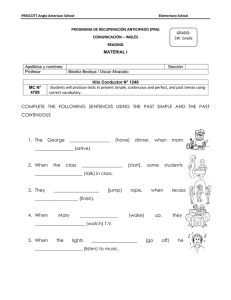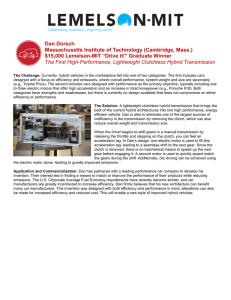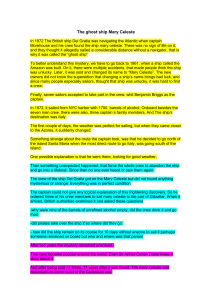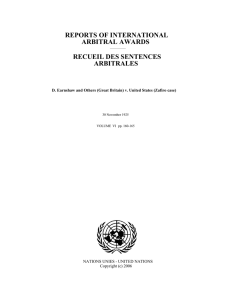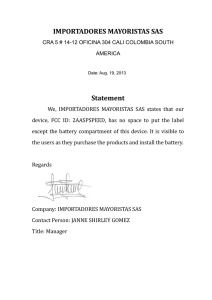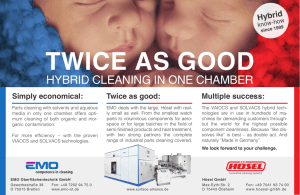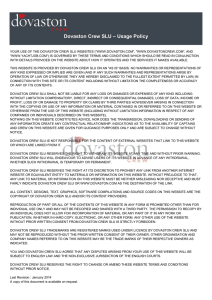Hybrid Fire Extinguisher Technology for Armored Vehicles
Anuncio
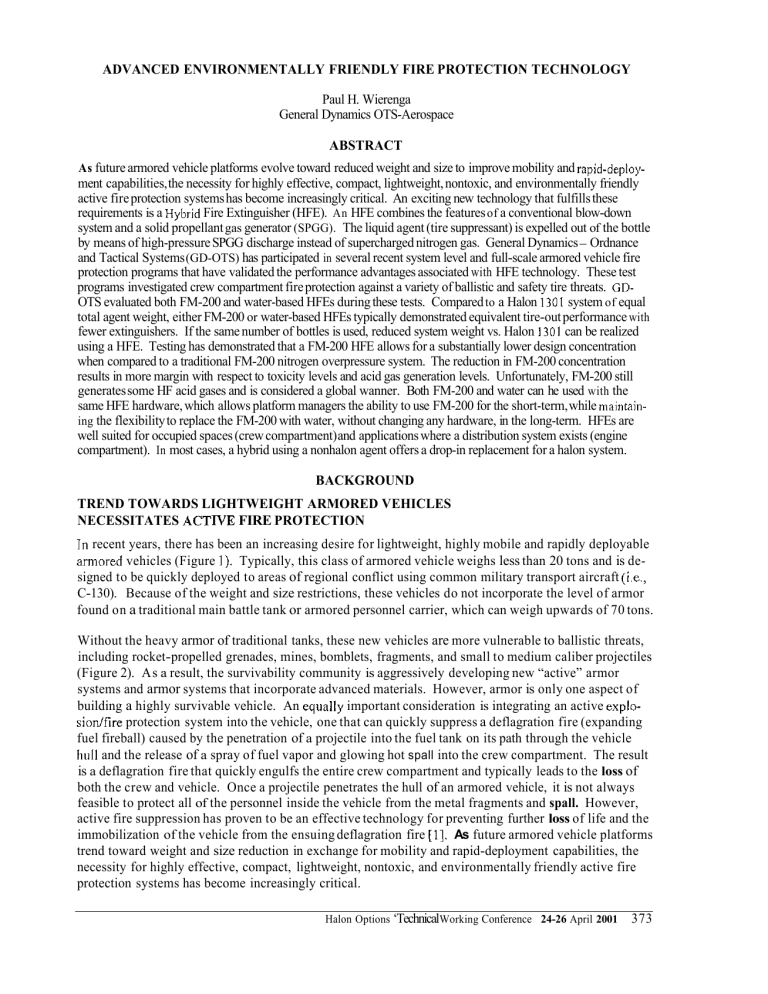
ADVANCED ENVIRONMENTALLY FRIENDLY FIRE PROTECTION TECHNOLOGY Paul H. Wierenga General Dynamics OTS-Aerospace ABSTRACT As future armored vehicle platforms evolve toward reduced weight and size to improve mobility and rapid-deployment capabilities, the necessity for highly effective, compact, lightweight, nontoxic, and environmentally friendly active fire protection systems has become increasingly critical. An exciting new technology that fulfills these requirements is a Hybrid Fire Extinguisher (HFE). An HFE combines the features of a conventional blow-down system and a solid propellant gas generator (SPGG). The liquid agent (tire suppressant) is expelled out of the bottle by means of high-pressure SPGG discharge instead of supercharged nitrogen gas. General Dynamics Ordnance and Tactical Systems (GD-OTS) has participated in several recent system level and full-scale armored vehicle fire protection programs that have validated the performance advantages associated with HFE technology. These test programs investigated crew compartment fire protection against a variety of ballistic and safety tire threats. GDOTS evaluated both FM-200 and water-based HFEs during these tests. Compared to a Halon 1301 system of equal total agent weight, either FM-200 or water-based HFEs typically demonstrated equivalent tire-out performance with fewer extinguishers. If the same number of bottles is used, reduced system weight vs. Halon 1301 can be realized using a HFE. Testing has demonstrated that a FM-200 HFE allows for a substantially lower design concentration when compared to a traditional FM-200 nitrogen overpressure system. The reduction in FM-200 concentration results in more margin with respect to toxicity levels and acid gas generation levels. Unfortunately, FM-200 still generates some HF acid gases and is considered a global wanner. Both FM-200 and water can he used with the same HFE hardware, which allows platform managers the ability to use FM-200 for the short-term, while maintaiuing the flexibility to replace the FM-200 with water, without changing any hardware, in the long-term. HFEs are well suited for occupied spaces (crew compartment) and applications where a distribution system exists (engine compartment). In most cases, a hybrid using a nonhalon agent offers a drop-in replacement for a halon system. ~ BACKGROUND TREND TOWARDS LIGHTWEIGHT ARMORED VEHICLES NECESSITATES ACTIVE FIRE PROTECTION In recent years, there has been an increasing desire for lightweight, highly mobile and rapidly deployable armored vehicles (Figure I). Typically, this class of armored vehicle weighs less than 20 tons and is designed to be quickly deployed to areas of regional conflict using common military transport aircraft (i.e., C-130). Because of the weight and size restrictions, these vehicles do not incorporate the level of armor found on a traditional main battle tank or armored personnel carrier, which can weigh upwards of 70 tons. Without the heavy armor of traditional tanks, these new vehicles are more vulnerable to ballistic threats, including rocket-propelled grenades, mines, bomblets, fragments, and small to medium caliber projectiles (Figure 2). As a result, the survivability community is aggressively developing new “active” armor systems and armor systems that incorporate advanced materials. However, armor is only one aspect of building a highly survivable vehicle. An equally important consideration is integrating an active explosiodfire protection system into the vehicle, one that can quickly suppress a deflagration fire (expanding fuel fireball) caused by the penetration of a projectile into the fuel tank on its path through the vehicle hull and the release of a spray of fuel vapor and glowing hot spall into the crew compartment. The result is a deflagration fire that quickly engulfs the entire crew compartment and typically leads to the loss of both the crew and vehicle. Once a projectile penetrates the hull of an armored vehicle, it is not always feasible to protect all of the personnel inside the vehicle from the metal fragments and spall. However, active fire suppression has proven to be an effective technology for preventing further loss of life and the immobilization of the vehicle from the ensuing deflagration fire [I]. As future armored vehicle platforms trend toward weight and size reduction in exchange for mobility and rapid-deployment capabilities, the necessity for highly effective, compact, lightweight, nontoxic, and environmentally friendly active fire protection systems has become increasingly critical. Halon Options ‘TechnicalWorking Conference 24-26 April 2001 373 T Figure 1. Trend towards mobility. Figure 2. Typical threats. HALON 1301 ACTIVE FIRE PROTECTION SYSTEMS ARE NO LONGER A SOLUTION Halon 1301 has been the agent of choice for active fire protection systems since the early 1970s. Unfortunately, halons are a class of ozone depleting substances and fall under international legislation that bans the manufacture and use of these substances [2]. In accordance with this legislation, the US Army Tank Automotive Command (TACOM) has aggressively pursued a “non-ozone depleting solution” for use in Army ground vehicles [l]. With the search for a Halon 1301 replacement, much of the fire suppression community has focused on a “drop-in” agent that is environmentally friendly, effective, and nontoxic. A number of agents have been evaluated, and several are listed in Table 1 (shortcomings are shaded) [2-51. Unfortunately, all of these have an Achilles heel (i.e., poor performance, poor dispersion, or toxicity issues). Many of these next generation agents suffer from higher boiling points than Halon 1301. Those with higher boiling points, generally classified as streaming agents, result in inferior vaporization and dispersion qualities, compared to Halon 1301, when released from a nitrogen-pressurized bottle. For example, FM-200 boils at -16.4 OC (2.55 OF) [4], which classifies it as a streaming agent. Therefore, at cold conditions (-25 OF), a nitrogen overpressure FM-200 system discharges mostly liquid (77%). As a result, carefully designed nozzles are needed to distribute the FM-200 uniformly throughout the protected compartment to prevent gross variations in agent concentration. Nozzle design is critical for the crew compartment because a liquid dispersing nozzle will have a large impact on flow rate and, therefore, on suppression time [I]. This effect is exacerbated hy the decrease of nitrogen overpressure at low temperatures [6]. So while FM-200 appears to be environmentally acceptable and relatively safe for use in occupied spaces, vehicle manufacturers should be concerned about the long time it takes a nitrogen overpressure FM-200 system to suppress a typical deflagration fire compared to Halon 1301. In a fire situation, suppression time is proportional to energy release and therefore to burn levels. Thus, more fire suppressant is required to extinguish the fire. Unfortunately, there is not much safety margin between the FM200 design concentration and LOAEL concentration [5]. Care must be taken in balancing design concentrations of halon replacement agents with expected levels of toxic agent decomposition products. Typical hydrofluorocarbons, e g , HFC-227, are pyrolyzed in a flame and produce toxins such as hydrofluoric acid (HF), fluorphosgene (COF2) as well as carbon monoxide (CO) and unsaturated hydrocarbons (e.g., CF,CFCF,) [5]. The approximate lethal concentration for HF (15 min exposure) is 2500 ppm. Production ofHF from HFCs is 5-lox greater than for Halon 1301, with measured HF levels in flame suppression studies typically exceeding 1000 ppm, sometimes up to 374 Halon Options Technical Working Conference 24-26 April 2001 TABLE 1. PROPERTIES OF SIX COMMON FIRE SUPPRESSION AGENTS. Agent Chemical formula Boiling point (T) Minimum design concentration (Val.%) Typical design concentration (Vol. %) Toxicitv NOAEL (%) Halon 1301 HFC- I25 (Engine Only) HFC-227ea (FM200) CBrF, -58 CJ5H -49 CP,H 5.0 10.9 FIC-I31 I (Engine Only) CF,I Water -17 HFC-236fa (FE-36) C,F& -2 -23 IO0 7.0 6.2 3.6 61 7s 7.5 90 IO 4.4 25.0 0.4 NA LC,,, v/v% ODP (rel. to CFC- I I ) GWP (rel. to CO,) Atmospheric life (yrs) NOAEL =No Observable Adverse Effect Level LOAEL =Lowest Observable Adverse Effect Level ODP = Ozone Depletion Potential, measured vs CFC-I 1 GWP = Global Warming Potential, measured vs CO, LC,,=Lethal Concentration that kills 50% of rat population w l 4 h exposure 5000 ppm. HF acid gas is known to be highly toxic, corrosive, and caustic. Testing has shown it to etch displays and damage electronics. When inhaled by personnel, HF stings nasal passages and stimulates a flight instinct. This is not an acceptable situation for combat vehicle occupants. The challenge in finding fire suppression alternatives to Halon 1301 has been to develop a method for vaporizing and dispersing a suitable (environmentally and human friendly) agent in such a fashion that its shortcomings are overcome. An exciting new technology that fulfills these requirements is an HFE. An HFE combines the features of a conventional blow-down system and a solid propellant gas generator (SPGG) [ l , G S J . The liquid agent is expelled out ofthe bottle by means of high-pressure SPGG discharge instead of supercharged nitrogen gas. The heat transfer between SPGG gases and liquid agent promotes the existeiice of vapor-phase agent at discharge, even at cold temperatures. Adjusting the SPGG design determines the time-dependent agent discharge flow rate and vapor quality. The principal advantages of an HFE include increased agent flow rate control, improved agent distribution, reduced fire out times, higher fill density, improved cold temperature performance, reduction in two-phase effects, insensitivity to orientation, increased safety, and elimination of a fast-actuating solenoid valve [6,9]. As a result, boiling point is a non-issue, and these streaming agents become viable halon replacement candidates. Three excellent agents for use in a hybrid are HFC-227ea, HFC-236fa, and water. If one considers HFC-227ea, published data indicate that an agent weight increase of 70% is required to produce a performance equivalent to that of Halon 1301. Given a fixed bottle size, it is not feasible to remove the existing Halon 1301, replace it with HFC-227ea, and expect an equivalent tire suppression performance; however, live fire testing has demonstrated that it is possible if one uses a hybrid as the delivery method. By using a hybrid system instead of a conventional blow-down approach, it is possible to have the tire suppression effectiveness of a halon system without the weight and volume consequences. I n most cases, a hybrid system using a nonhalon agent offers a drop-in replacement for a halon system. HYBRID TECHNOLOGY AT GD-OTS General Dynamics (GD-OTS) has been a world leader in the development and production of solid propellant gas generators, hybrid gas generators, and stored gas systems for the past 30 years. GD-OTS maintains core businesses in the areas of fire suppression, automotive airbags, emergency escape slides for aircraft, buoyancy and flotation systems, and submunition dispensing systems. Halon Options Technical Working Conference 24-26 April 2001 375 GD-OTS has been involved with the development and production of pyrotechnic devices for commercial applications since the late 1960s, with much of this activity being devoted to automobile airbag inflators. The propellants GD-OTS has developed for airbag inflators are designed to exhaust a mixture of nitrogen, water vapor, and carbon dioxide gas. With the advent of a need for small and lightweight fire protection systems, and a desire to replace Halon 1301 as the agent of choice for fire suppression systems, GD-OTS initiated research and development efforts to apply the airbag technology to fire suppression. This effort resulted in a new gas generator propellant ideally suited for fire suppression applications. These devices are called Solid Propellant Fire Extinguishers (SPFE), and are at times referred to as Solid Propellant Gas Generators (SPGG) or Radial Fire Extinguishers ( W E ) [SI. GD-OTS has a family of SPFEs currently in production for the V-22 Osprey and the FIA-I SEIF SuperHornet aircraft (Figure 3). Full-scale fire testing has repeatedly demonstrated that GD’s SPFEs require a smaller quantity of agent than Halon 1301 to extinguish a fire (on a mass basis). Also, SPFE occupies a smaller volume since the density of a solid propellant is greater than that of Halon 1301. Figure 3. SPFEs are in production for the V-22 Osprey and F/A-ISEIF. While SPFE technology has proven to be an excellent nonhalon fire protection solution for a broad range of applications, current SNAP approval limits GD’s current generation of SPFE technology for use only in unoccupied spaces due to oxygen depletion concerns. As a result, GD-OTS has investigated alternative extinguisher technologies for use in occupied spaces, e.g., the HFE (Figures 4-6). GD-OTS has developed hybrid gas generator technology using a variety of fluids (Freon 22, Freon 32, Halon 1301, CO,, ammonia, H,O, and HFC-227ea) for numerous military and commercial applications since 1969. Over the years, GD-OTS has built thousands of hybrid systems using Freon as the liquid agent for inflation of Boeing 747 emergency escape slides. Additionally, GD-OTS is producing hybrid systems for inflation of the Navy H-46 helicopter emergency flotation bladders. Both of these production systems are currently in service. In 1994, GD-OTS began developing HFE for fire protection applications. Several HFE versions have been tested in a variety of full-scale fire fixtures since then. Hybrid fire extinguishers use a small quantity of solid propellant to produce inert gases. These exhaust gases are used to pressurize, vaporize, and expel a liquid or gaseous agent from a conventional bottle. To date, GD-OTS has evaluated C02, H,O, FM-200, and PFC-614 in a hybrid for fire suppression purposes. Use of a solid propellant system to pressurize, vaporize, and expel an agent offers several compelling advantages over conventional nitrogen pressurized fire extinguishers. 376 Halon Options Technical Working Conference 24-26 April 2001 Figure 4. HFEs are based on a long history of hybrid development at GI)-OTS. System Reedy for Function - agent stored 81 low pressure .hameticelly lealed -elcctrical or mechanical initlation Solid Propellant Burns - inrrl gas discharged into lank .g ~ hcab. f proarurllcs. v a p o ~ i ~ c ~ 8 mixes M l h liquid agent Fire Suppressant Discharges -"Po" prersuri2ation,uaive apenr -vaporlrcd su~preriantcipclled - agent completely discharged c i o h s Figure 5. Schematic of an HFE discharge process. Environrnentnl[ySrierIJly-GD-OTS hybrid fire extinguishers combine SNAP approved inert gas producing solid propellant gas generators with non-ozone depleting / nontoxic fire extinguishing agents such as HFC-227ea (FM200) and H,O (water). Upon discharge, the mixing and heat transfer between SPGG gases and liquid agent promote the existence of vapor-phase agent, increasing the discharge vapor quality even at low temperatures, and improving the homogeneous distribution of agent in the protected space. Thus, hybrid technology is very suitable for the so-called streaming agents, such as HFC-227ea and HFC236fa. These agents are usually considered less favorable for use in blow-down systems since their boiling points are high and vapor pressures low at discharge. Reduced sysienr weight-GD-OTS HFEs require less agent than conventional blow-down systems. The solid propellant facilitates vaporization o f a liquid agent to improve dispersion upon discharge. Testing has shown that the improved agent vaporization and distribution associated with an HFE results in reduced agent concentration rcquircinents for equivalent fire suppression performance. Additionally, storage volumes of liquid agents are considerably smaller than for gaseous agents. Since the pressurizing gas I-lalon Options Technical Working Conferencc 24-26 April 2001 377 Figure 6. Water hybrid discharge occurs in less than 100 msec. is stored in solid form until activation, the HFE requires no nitrogen charging; therefore, the agent storage pressure is much lower. For FM-200, the storage pressure of an HFE is around 60 psig at room temperature (Le., the vapor pressure of FM-200), which compares favorably to the 750 psig of a typical nitrogen charged system. Thermodynamically, this implies the agent loading density can be significantly increaseed without incurring the danger of overpressure at higher storage temperatures. As a result, the extinguisher can he packaged in a smaller volume. The combination of an improved dispersion of a liquid agent via a solid propellant system, reduced agent concentration requirements, the elimination of a nitrogen pressurant, and the reduced volume of a liquid agent make the hybrid system an attractive fire suppression solution. The result is a bolt-in replacement for current halon systems. Fasterfire-out times-Testing has shown that a hybrid system extinguishes the fire more rapidly than a pressurized system. Typically, a hybrid system discharges its entire agent load in half the time of a conventional blow-down system (discharge time can be further reduced if desired), thus reducing the amount of agent required and the formation of toxic decomposition and combustion products, and minimizing fire damage. Improved safetp-Actively pressurizing the agent with a solid propellant reduces the agent storage pressure resulting in a reduced system weight and a safer system for occupied applications. Personnel are no longer required to handle or sit next to a highly pressurized steelicomposite cylinder. Additionally, they are not susceptible to the frost bite exposure common to blow-down systems. Typical hybrid agent temperatures (upon discharge) measured within inches of the nozzle range from 0 to 300 O F . Within 1 ft of the nozzle, the temperatures have been measured to be less than 50 7 above ambient. Reduced maintenance costs-Since the liquid agent is stored at ambient pressure (70 psig for FM200 and 0 psig for water), the storage cylinder is not subjected to the considerable pressure cycles a conventional nitrogen pressurized bottle witnesses. The result is reduced fatigue stresses and maintenance requirements, and improved life cycle costs. Additionally, negligible storage pressures reduce leakage potential. Nitrogen solubility is not a concern-Without the need for nitrogen as a pressurant, there are no solubility issues. The result is a longer system life and improved life cycle costs. 378 Halon Options Technical Working Conference 24-26 April 2001 Temperature compensaling design-As compared to a pressurized system, the GD-OTS hybrid has negligible mass flow rate (performance) variation across the operational temperature range. Insensitive to orientation-Unlike nitrogen pressurized fire extinguishers, HFEs operate the same regardless oftheir orientation. This offers designers more flexibility when trying to identify an unobtrusive and acceptable mounting location for the fire extinguisher. QuaIifedsystems4D-OTS solid propellant is SNAP approved and qualified to MIL-D-21625. GDOTS hybrid systems are currently in use on both commercial aviation platforms and military platforms. Refurbishable design-Depending on the hybrid design, the entire SPGG can be replaced with a new unit (discarding the old unit in the trash) and the bottle refilled with agent. RECENT TEST PROGRAMS TACOM ARMORED VEHICLE CREW FIRE PROTECTION TESTS During 1998-2000, TACOM conducted a ground vehicle crew compartment live fire test program (Aberdeen Test Center, Aberdeen Proving Grounds, MD). The objective of the test program was to evaluate technologies that are viable replacements for Halon 1301. The TACOM crew compartment test program consisted of two phases. A Basic Contract Requirements (BCR) phase provided initial screening of contractor’s extinguisher. A follow-on Option 1 phase was awarded by TACOM based upon the performance achieved in the BCR phase. In both phases, threats tested against included spray fire (fireball) and ballistic (shape-charge) events. Test data were compared to technical requirements and performance demonstrated with conventional Halon 1301 nitrogen-charged extinguishers. ATC personnel performed the Halon 1301 testing using existing 5 Ib (144 in’) and 7 Ib (204 in’) halon extinguishers. The test fixture (Figure 7) used during the program was representative of a standard armored vehicle (crew compartment) and had an internal volume of approximately 450 ft’ (gross). Four extinguisher locations were provided but were not always utilized. During the BCR phase, no clutter was used. Clutter added to Option 1 testing included mannequins and TOW missile simulators to further challenge the extinguisher’s capabilities. Pertinent test data measured included fire-out time (IR and video), acid gas production, heat flux, temperature, pressure, agent, and oxygen concentration. Test requirements of the contract included (1) fire-out time Q50 msec; (2) acid gas production <IO00 ppm; (3) heat flux 12400 OF-sec; (4) pressure < I 1.6 psid; (5) 0, level >16%; and (6) agent level <NOAEL. Real time measurements of fire-out time and acid gas production were used to make test configuration decisions. 0 0 spray Path I /Shotline Thermocouple Pressure Transducer Toxic Fumes Line Camera IR Sensor Extinguisher Bottle FuelCell (Ballistic Only) Taw Missile Slrnulator Mannequin (Option 11 Figure 7. TACOM test fixture setup. Halon OptionsTechnical Working Conference 24-26 April 2001 379 GD-OTS provided both FM200 and Water HFEs for this test program. During the BCR test series, experiments were designed and set up to evaluate the HFE design parameters deemed important to minimize fire-out time, heat flux, and acid gas production. Test data were compared to contract performance specifications and with baseline Halon 1301 data. As a result of the design of experiments, the GD-OTS FM200 HFE demonstrated superiorperformance to Halon 1301 on a weight basis. The HFE system was selected by TACOM for the follow-on Option 1 testing. This test series further challenged the extinguisher's capabilities by adding clutter to the fixture and evaluating performance at cold conditions. During ballistic testing, both the FM-200 and water-based HFE showed superior fire-out performance to Halon 1301 on a weight, volume, temperature, and bottle quantity basis. Acid gas levels are significantly lower with FM-200 HFE and nonexistent with water-based HFE. Compared to Halon 1301 system ofequal total agent weight, either FM-200 or water-based HFE demonstrated equivalent fire out performance with one less extinguisher. If the same number of bottles is used, significant weight improvements can be realized using an HFE. Equivalent Halon 1301 (4 ea. for a IO Ibm total) performance was demonstrated with either 2 ea. (1 5 Ibm total) or 3 ea. (12 Ibm total) FM200 HFE configurations (Figure 8). If the same number of bottles is utilized, significant weight improvements can be realized using a HFE. Additionally, equivalent Halon 1301 (4 ea. for a IO Ibm total) performance was demonstrated with 3 ea. (IO Ibm total) water hybrids. 14.0.. E P, 12.0.. E -a, 10.0.. i ! + $ 8.0 ._ 6.0 __ 4.0 .. 2.0 .. 2 'X Fire Extinguisher Configuration Halon-1301 N. Overpressure System FM-?OD Hybrid Fire Extlngulsher water HyWid Fira Extinguisher Figure 8. HFEs offer performance advantages. EUROPEAN ARMORED VEHICLE CREW FIRE PROTECTION TESTS In early 2001, the German Armed Forces (GAF) conducted a ground vehicle crew compartment live fire test program. The objective of the test program was to evaluate FM-200 and Water HFEs for application in the currently under development European Multi-Role Armored Vehicle (MRAV). Personnel at the Wehnvissenschafiliches Institut fur Schutztechnologien (WIS) in Munster, Germany performed the test program. The MRAV is intended to be a family of lightweight, highly mobile and rapidly deployable armored vehicles, much like the medium brigade class of vehicles the US Army is currently developing. It is comparable in size to the LAV, IAV, FOX, and Pandur. 380 Halon Options Technical Working Conference 24-26 April 2001 Like other lightweight armored vehicles in its class, the MRAV may be susceptible to rocket-propelled grenades, mines, bomblets, and various caliber projectiles. As such, it is desirable to incorporate an active fire protection system in the crew compartment. However, unlike some other vehicles in its class, the MRAV is a new vehicle and is intended to be in service for the next 30+ years. Therefore, any fire protection system should incorporate a suppressant that will be environmentally acceptable and readily available for the duration of the vehicles’ fielded life. Halon is not an option, and potential halon replacements with high global warming values (e.g., FM-200 and FE-36) are frowned upon. As a result, water is viewed as a favorable alternative solution. Given this, the GAF developed a full-scale fire test program to evaluate the performance attributes of FM-200 and Water hybrids for the MRAV crew compartment. A full-scale stainless steel test article (Figure 10) was built for the test program per the geometric specifications of the current MRAV design. The gross volume of the crew compartment, including the drivers’ area, is approximately 5 15 ft’. The volume of the MRAV crew compartment is somewhat larger than the 450 ft’ volume of the crew compartment test article used during the TACOM test series, which was based on a Bradley fighting vehicle hull. During this first phase of MRAV fire protection system testing and evaluation, no clutter or mannequins were installed in the test article, although future testing incorporating clutter and mannequins is planned. A baseline test condition, developed by WIS personnel, is representative of a mine or explosive projectile that penetrates the hull of the vehicle through a fuel tank, spraying fuel vapor and hot fragments into the crew compartment. The objective was to reproduce a deflagration fire scenario in the test article in a consistent and repeatable fashion. This was achieved by using a high-pressure fuel spray and a glowing hot ignition source. The specific test parameters are listed below. This test scenario is very similar to that used by TACOM during the US Crew Compartment Fire Protection Program for Ground Vehicles; however, for that testing, the fuel spray duration was l .2 sec and the ignition source was left on for 2 sec. 1 . 1200 psi diesel /heptane fuel spray 2. Fuel heated to 85 ‘C ( 1 85 ’F). 3. Fuel spray nozzle located inside the crew compartment Halon Options Technical Working Conference 24-26 April 2001 38 1 4. Fuel spray directed at a 2 ft diameter reflective shield with a “glowing” hot ignition source in the middle. 5. Fuel spray duration of 2.5 sec. 6. Hot ignition source is always on. The baseline deflagration fire scenario developed for the MRAV test program proved to be very challenging. Aside from the larger volume of the MRAV crew compartment versus the crew compartment used during the TACOM testing, the initial deflagration fire threat was of a similar intensity during both test programs. However, the 2.5 sec duration fuel spray and existence of a continuous hot ignition source produced a more challenging re-flash scenario during the MRAV versus the TACOM test program. The presence of a reignition source for 2.5 sec is representative of a threat where larger fragments of hot spall are present inside the crew compartment after the initial explosion. The existence of a hot ignition source for such a long time after the initial explosion severely challenges the active fire protection system. The system must be designed to extinguish the initial expanding fuel fireball quickly, but also produce an atmosphere inside the crew compartment that suppresses any attempt to re-flash, without harming personnel or equipment inside the armored vehicle. The objective of the test program was to evaluate the performance of FM-200 and Water HFEs in the MRAV crew compartment test article given the following performance criteria: Deflagration fire detection and suppression in less than 250 msec. Reignition (re-flash) suppression for more than 2.5 sec. Overpressure less than 3.5 psi (eardrum damage threshold). Maintain oxygen concentration greater than 16%. Use a nontoxic, non-ODP and low GWP suppressant. Testing was conducted following a procedure intended to replicate real-world installation and operation of the fire protection system. As such, the HFEs were not functioned at a predetermined time after initiation of the fire event. Instead, the entire fire protection system, including optical fire sensors and an electronic controller, were integrated into the test article. The optical fire sensors were mounted inside the test article (Figure 1 I), as they would be in an actual vehicle. And the electronic controller was used to provide power to the entire fire protection system, as well as process a fire detection signal from one of the sensors and function all of the HFEs in response. This full-up system testing was mandated in the test procedure since one of the success criteria of the test program was that the entire event, fire detection and suppression, occur in less than 250 msec. A standard test procedure was followed during the test program to ensure test consistency: 1. Power-up fire protection system (provide power to electronic controller). Turn on data acquisition system. 2. Turn on hot ignition source. 3. Pressurize fuel spray system (verify fuel is at temperature). 4. Initiate the fire event. 5. Fast-acting solenoid value releases fuel spray. 6. Fuel spray discharges into crew Compartment. I. Fuel spray impinges on glowing hot ignition source and reflects off dish in all directions, 8. creating a cloud of fuel vapor. Crew compartment is engulfed in a rapidly expanding fuel fireball. 9. IO. Fuel spray continues for 2.5 sec. 11. Fire protection system reacts by detecting the fire and signaling all ofthe HFEs to function. 12. Success criteria. 382 Halon Options Technical Working Conference 24-26 April 2001 Crew Area Test Configuration -L OvkalFire DReCIolS GA nn Hybrid Fire E*llnguisheis (5 b m F W 2 0 0 o r 4 3 I b r n W ~ e r ) up104 each .54'diamler 13.lmglh f . Figure 11. Fire protection system configuration. 13. 14. 15. 16. If the fire is extinguished (within 250 msec) and there are no re-flashes, the test is considered a success If the fire is not extinguished (within 250 msec) or if there is a re-flash during the time the fuel spray is on, the test is considered a failure. In the event that the fire extinguishing system does not suppress the fire or there is a re-flash, the fire continued to burn for the duration that the fuel spray was active (2.5 sec). The test article was ventilated and cleaned between tests to maintain a consistent and reproducible test environment. Data acquisition during the test program included: 1 . Independent UV and IR fire sensors to determine exact fire ignition and suppression times. 2. Thermocouples mounted at various locations inside the crew compartment to determine peak temperatures. 3. Pressure transducers inside the crew compartment to determine overpressure. 4. Oxygen concentration inside the crew compartment. 5. Video coverage. 6. Two DV cameras mounted on opposing comers inside the crew compartment. 7. One DV camera mounted outside the test article. One advantage associated with the GD HFEs is that both the FM-200 and the Water hybrids use the same hardware. For the purposes of this test program, this simplified the test process and enabled the WIS personnel to test both agents back-to-back without changing hardware or mounting brackets. In the field, this offers a great advantage to armored vehicle platform program managers. If a decision is made to use FM-200 for the near-term, platform managers can easily switch to water in the future, without having to change any hardware in the vehicle. The only difference between the two hybrid systems is the quantity of agent in the bottle. Given the same bottle size and propellant cartridge configuration, the FM-200 hybrid is loaded with 5 Ibm ofFM-200 suppressant and the water hybrid with 4.3 Ibm of water solution. Halon Opiions'lechnical Working Conference 24-26 April 2001 383 Per the TACOM specifications, the FM-200 contains a 10% (by weight) addition of sodium bicarbonate as a scavenger, and the water solution is a 50/50 mixture of water and potassium acetate (freezing point depressant to -60 "C). The water solution also contains a very small addition of soap as a surfactant. This water solution has passed extensive toxicity, corrosivity, material compatibility, and environmental evaluations by the EPA, TACOM, and the US Air Force. This solution is inexpensive, commercially available, nonflammable, and does not separate in storage (Figure 12). 250 g inert gas propellant cartridge Figure 12. Both the FM-200 and Water hybrids use the same hardware. Three optical fire detectors were evaluated during the test program. Sensor A was a traditional analog type dual spectrum IR detector, Sensor B was a traditional analog type UVOR detector, and Sensor C was a digital type dual spectrum IR detector. All of the fire detectors were mounted in the same location on the inside the crew compartment, which was done to ensure that all three detectors were exposed to the same level of fire radiation when the compartment fire was initiated. Multiple tests were conducted using various FM-200 and Water HFE quantities as well as suppressant loads. Additionally, tests were conducted using all three optical fire detectors. The test results showed that both the Water and FM-200 hybrids are capable of meeting the performance requirements. However, success and total fire-out time is a function of using a responsive optical tire detector as well as using the correct agent load and extinguisher quantity. The digital optical fire detector demonstrated the quickest fire detection time. Response times ranged from 10 to 20 msec. The analog type optical fire detectors demonstrated slower response times. Sensor A responded in 80-100 msec; Sensor B responded in 40-60 msec. Increased response times from the optical detectors resulted in increased fire-out times. A 80-100 msec response time is too slow to achieve the total fire detection and suppression criteria of 250 msec. Three hybrid fire extinguisher mounting configurations were evaluated during the test program (Figures 13-15). Configuration A: In this configuration, the hybrid extinguishers are mounted in the four comers of the crew area, with all of the nozzles pointed in towards the center of the crew area. Using Configuration A, four each 4.3 lbm water hybrids or three each 5 Ibm FM-200 hybrids were required to extinguish the fire adequately and prevent re-flashes. The fire-out time was approximately 300 msec; therefore, the desired 250 msec fire-out time was not achieved. Review of the test videos indicates that the lengthy fire-out time is partly attributed to the distance (approximately 8 A) from the hybrid fire extinguisher mounting locations to the initiation source of the fireball. Configuration B: The hybrids are staggered along the side of the crew area, such that the diagonally opposing extinguishers are in the opposing comers with the nozzles pointed about 30 deg in from perpendicular off the wall. The other two mounting locations are 113 and 2/3 up from the back of the crew area, on opposing sides of the vehicle from the comer bottles, the nozzles of which point perpendicularly off the side wall. If one were to start at the back of the crew area and move fonvard, the layout would be 3 84 Halon Options Technical Working Conference 24-26 April 2001 Figure 13. MKAV test fixture setup (Confieurntion A). Figure 14. Water hybrids offer excellent vauorization and d i s n e r k n Figure 15. Two ceiling mounted Water HFEs extingush fire, time < 195 msec Halon Optlons Techmcal Workmg Conference 24-26 April 2001 3 85 as follows: at the back wall, bottle on left side; at 1/3 forward, bottle on right side; at 213 forward, bottle on left side; and at the Front, bottle on right side. The nozzles are directed such that the plumes From the hybrid bottles just overlap each other. The advantage ofthis configuration is that it decreases the distance from a hybrid bottle to any potential fire location in the crew area. In the baseline fire scenario, this distance is approximately 4 ft. Decreasing the distance the agent travels reduces the fire-out time. Using Configuration B, the baseline fire was successfully extinguished, without any re-flashes, with either three or four each 4.3 water hybrids and with three each 5 Ibm FM-200 hybrids. The fire-out time was approximately 240 msec. Configuration C: WIS Engineers suggested this configuration. The fuel tank for the MRAV is located under the crew area. A principal objective of the crew fire protection system is to suppress any deflagration fires that are caused by a mine exploding through this fuel tank into the crew area. Since the crew area is going to be full of personnel and equipment, the most direct and least cluttered path is to discharge the two hybrids (attached horizontally to the ceiling, with the nozzles pointing straight down) down from the ceiling of the vehicle so that the plume adequately covers the entire crew area and fuel tank zone. While this is possible with an HFE, due to its insensitivity to orientation, it is not possible to orient a conventional nitrogen overpressure fire suppression bottle horizontally and expect nominal performance. Configuration C required the least suppressant to extinguish the baseline fire and produced the fastest fireout times (approximately 195 msec). In summary, both the FM-200 and Water HFE successfully extinguished the baseline fire threat and prevented re-flashes (Figure 16). However, only mounting Configurations 2 and 3 met the desired 250 msec fire-out time objective, Additionally, overpressure of less than 3.5 psi and oxygen concentration of more than 16% were recorded during all of the successful tests. Typically, the oxygen concentration did not drop below 18.5% during a successful test '"'"i 16.0 ' Figure 16. FM200 and Water hybrids met the performance criteria. Fire faingubher Contiguralion As one would expect, increasing agent load and extinguisher quantity results in reduced fire-out times. However, in the constricted confines of an armored vehicle crew compartment it is desirable to reduce the size and quantity of fire extinguishers required. HFEs have been proven to be effective for extinguishing deflagration type fires with weights of less than the common fire suppressants such as FM200 and water. This improved effectiveness is primarily attributed to the more efficient storage, pressurization, vaporization, and dispersion of these suppressants from the fire extinguisher bottle. 386 Halon Options Technical Working Conference 24-26 April 2001 While both FM-200 and Water are considered nonozone depleting agents, FM-200 has a very high global warming potential versus none for water. This makes water a much more attractive solution for countries that are aggressively pursuing the goals set by the Kyoto agreement. From a toxicity standpoint, both FM-200 and water are approved for occupied spaces. However, the design concentration (9.0%) and the LOAEL concentration (10.5%) are quite close, without much room for margin. FM-200 is considered a streaming agent. As such, it is highly likely there will be zones of both high and low concentrations of FM-200 after a discharge into a crew compartment. To achieve a mean concentration of 9.5%, there will be zones where the concentration is higher than 10.5%. This phenomenon is exacerbated at cold temperatures. Using a hybrid to disperse the FM-200 improves this situation two ways: ( I ) the FM-200 is better vaporized which leads to more uniform distribution, and (2) less concentration is required to cxtinguish the fire. Thus, more margin exists between the design concentration and the LOAEL concentration. In the case of a crew compartment application, where the occupants do not have the luxury of stepping out of the vehicle after a fire extinguisher discharge, these details are extremely critical. Toxicity concerns aside, testing with FM-200 resulted in generation of HF gases. The levels of HF gas generated appear to he directly related to the fire-out times. This is well documented in the scientific community since HF is a byproduct from the pyrolysis of FM-200. During the MRAV test program, it was observed that if a fire was not extinguished within 250 msec using FM-200, excessive quantities of HF were produced. In one case, exposed metal hardware was severely corroded and video camera lenses were etched. This leads one to postulate that, if there is an extremely aggressive deflagration fire inside a crew compartment and the FM-200 fire suppression system requires more than 250 msec to extinguish the fire successfully, it is possible that the crew will die and/or hardware and electronics inside the vehicle will be permanently damaged. This worst case scenario highlights a critical advantage the water hybrid system offers. There are no toxicity or environmental issues associated with it, none. As such, the negligible increase in suppressant weight might be considered a nowissue. CONCLUSIONS HFEs use a small quantity of solid propellant to produce inert gases. These exhaust gases are used to pressurize, vaporize and expel a liquid or gaseous agent from a conventional bottle. An HFE is merely the integration of a solid propellant gas generator and a conventional fire suppression bottle (minus the valve and nitrogen). This integration can be accomplished via several approaches, depending on the needs of the specific application. These approaches are well suited for occupied spaces (crew compartment) and applications where a distribution system or plumbing exists (engine bay). Sizing analysis conducted by GD-OTS have shown that an HFE incorporating a halon replacement agent can be used to replace an existing halon system without size or performance penalties. Testing has verified the performance advantages associated with a hybrid system: increased agent flow rate control, improved agent distribution, reduced discharge time, higher fill density, improved cold temperature performance, reduction in two-phase effects, insensitivity to orientation, increased safety, and elimination of a fast-actuating solenoid valve. Full-scale fire testing conducted by the US Armed Forces at TACOM and the German Armed Forces at WIS have validated the benefits of HFEs for ground vehicle crew compartment fire protection. These test programs investigated crew compartment fire protection against a variety of ballistic and safety fire threats. GD-OTS evaluated both FM-200 and water-based HFEs during these test programs. Compared to a Halon 1301 system of equal total agent weight, either FM-200 or water-based HFEs typically demonstrated equivalent fire-out performance with fewer extinguishers. If the same number of bottles is used, reduced system weight versus Halon 1301 can be realized using an HFE. Halon Options Technical Working Conference 24-26 April 2001 387 Both FM-200 and water can be used in the same HFE hardware, allowing platform managers the ability to use FM-200 for the short-term, while maintaining the flexibility to replace the FM-200 with water, without having to change any hardware, in the long-term. As future armored vehicle platforms evolve toward reduced weight and size to improve mobility and rapid deployment capabilities, the need for highly effective, compact, lightweight, nontoxic, and environmentally friendly active fire protection systems has become increasingly critical. HFEs fulfill this need. ACKNOWLEDGMENTS The authors would like to thank the support of GD-OTS management, especially Robert Peha, John Italiane, Terry Scodeller, and Mark Schneider. The help of Keith Krasnowski, George Price, Chuck Anderson, and Warren Henry for design, manufacturing, and testing GD-OTS HFEs is greatly appreciated. Additionally, the authors would like to acknowledge Rainer Pauli, Christian Matiszik, ‘Krazy’ Karl Heinz, and the crew (WIS, Germany) and Steve McCormick and his crew (TACOM) for their efforts. REFERENCES 1, Mitchell, R., “Crew Compartment Live Fire Test Results with Hybrid Gas Generators,” Proceedings, Halon Options Technical Working Conference, Albuquerque, NM, pp. 469-479, 1999. 2. Harrison, G.C., “Halon Replacement in Aircraft and Industrial Applications,” Halon Replacements: Technology and Science,” ACS Symposium Series, Vol. 61 1, p. 74, 1995. 3. Wuebbles, D.J., et al., “Evaluating the Potential Effects of Halon Replacements on the Global Environment,” Halon Replacements: Technology andscience, ACS Symposium Series, Vol. 61 I, p. 59, 1995. 4. Robin, M.L., “Halogenated Fire Suppressants,” Halon Replacements: Technology and Science, ACS Symposium Series, Vol. 61 I , p. 85, 1995. 5. Skaggs, S.R., et al., “Toxicological Properties of Halon Substitutes,” Halon Replacements: Technology andScience, ACS Symposium Series, Val. 61 1, p. 99, 1995. 6. Lu, Y.C., and Wierenga, P.H., “Further Advances in the Development of Hybrid Fire Extinguisher Technology,” Proceedings, Halon Options Technical Working Conference, Albuquerque, NM, pp. 371-383,2000, 7. Fallis, S., Reed, R., Lu, Y.C., Wierenga, P.H., and Holland, G.F., “Advanced Propellant!Additive Development for Fire Suppressing Gas Generators,” Proceedings, Halon Options Technical Working Conference, Albuquerque, NM, pp. 361-370,2000. 8. Wierenga, P.H., and Holland, G.F., “Developments in and Implementation of Gas Generators for Fire Suppression,” Proceedings, Halon Options Technical Working Conference, Albuquerque, NM, pp. 453-468, 1999. 9. Klueg, E.P., and Demaree, J.E., “An Investigation of In-Flight Fire Protection with a Turbofan Powerplant Installation,” Final Report, No. NA-69-26, Federal Aviation Administration, 1969. 388 Halon Options Technical Working Conference 24-26 April 2001
